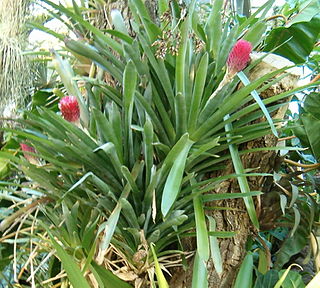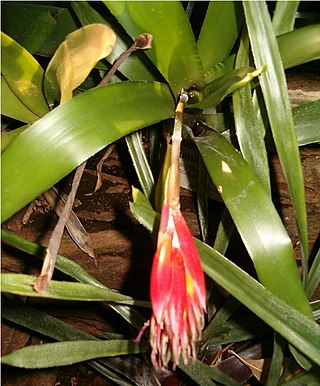
Nidularium is a genus in the plant family Bromeliaceae, subfamily Bromelioideae. Named to describe the nestling characteristic of the inflorescence, all the species are endemic to Brazil. Commonly confused with Neoregelia which they resemble, this plant group was first described in 1854.

Quesnelia is a genus of flowering plants in the family Bromeliaceae, subfamily Bromelioideae. The genus is named after French businessman and patron of botany Edouard Prosper Quesnel, of Le Havre (1781–1850). Endemic to eastern Brazil, this genus contains 22 known species. This genus has two recognized subgenera: the type subgenus and BillbergiopsisMez.

Quesnelia marmorata is a species of flowering plant in the family Bromeliaceae, endemic to the Atlantic Forest ecoregion of southeastern Brazil. It was first described by Charles Antoine Lemaire in 1855 as Billbergia marmorata.
Aechmea atrovittata is a species of flowering plant in the genus Aechmea. This species is endemic to the State of Alagoas in eastern Brazil.
Wittmackia bicolor is a species of flowering plant in the family Bromeliaceae, endemic to south Brazil. It was first described by Lyman Bradford Smith in 1955 as Aechmea bicolor.

Aechmea marauensis is a species of flowering plant in the genus Aechmea. This species is endemic to the State of Bahia in eastern Brazil.

Aechmea purpureorosea is a plant species in the genus Aechmea. This species is endemic to southeastern Brazil, States of Minas Gerais and Rio de Janeiro.

Karawata saxicola is a species of flowering plant in the family Bromeliaceae, native to southeastern Brazil, in the states of Espírito Santo and Rio de Janeiro. It was first described by Lyman Bradford Smith in 1950 as Aechmea saxicola.
Billbergia tweedieana is a species of flowering plant in the Bromeliaceae family. This species is endemic to southeastern Brazil.
Rokautskyia pseudoscaposa is a species of flowering plant in the family Bromeliaceae, endemic to Brazil. It was first described by Lyman Bradford Smith in 1955 as Cryptanthus pseudoscaposus.
Quesnelia augustocoburgii is a species of flowering plant in the family Bromeliaceae, endemic to Brazil. It was first described by Heinrich Wawra von Fernsee in 1880. It is found in the Atlantic Forest ecoregion of southeastern Brazil. The name is sometimes spelt with a hyphen as Quesnelia augusto-coburgii.
Quesnelia dubia is a species of flowering plant in the family Bromeliaceae, endemic to Brazil. It was first described in 2005. It is found in the Atlantic Forest ecoregion in southeastern Brazil.

Quesnelia humilis is a species of flowering plant in the family Bromeliaceae, endemic to Brazil. It was first described by Carl Christian Mez in 1892. It is found in the Atlantic Forest ecoregion of south and southeastern Brazil.
Quesnelia imbricata is a species of flowering plant in the family Bromeliaceae, endemic to Brazil. It was first described by Lyman Bradford Smith in 1952. It is found in the Atlantic Forest ecoregion of southeastern Brazil.
Quesnelia indecora is a species of flowering plant in the family Bromeliaceae, endemic to Brazil. It was first described by Carl Christian Mez in 1892. It is found in the Atlantic Forest ecoregion of southeastern Brazil.

Quesnelia liboniana is a species of flowering plant in the family Bromeliaceae, endemic to southeastern Brazil. It was first described in 1851 as Billbergia liboniana. It is found in the Atlantic Forest ecoregion of southeastern Brazil.

Quesnelia seideliana is a species of flowering plant in the family Bromeliaceae, endemic to Brazil. It was first described in 1963. It is found in the Atlantic Forest ecoregion within Rio de Janeiro state, in southeastern Brazil.
Quesnelia blanda is a species of flowering plant in the family Bromeliaceae, endemic to southeastern Brazil. It was first described in 1856 as Bromelia blanda. As of November 2022, the Encyclopaedia of Bromeliads listed it under the synonym Quesnelia strobilospica, which it spelt Quesnelia strobilispica.
Vriesea heterostachys is a species of flowering plant in the Bromeliaceae family. The bromeliad is endemic to the Atlantic Forest biome, located in southeastern Brazil.

Tillandsia tenuifolia, the narrowleaf airplant, is a species in the genus Tillandsia. This species is widespread across much of South America and the Caribbean islands.










